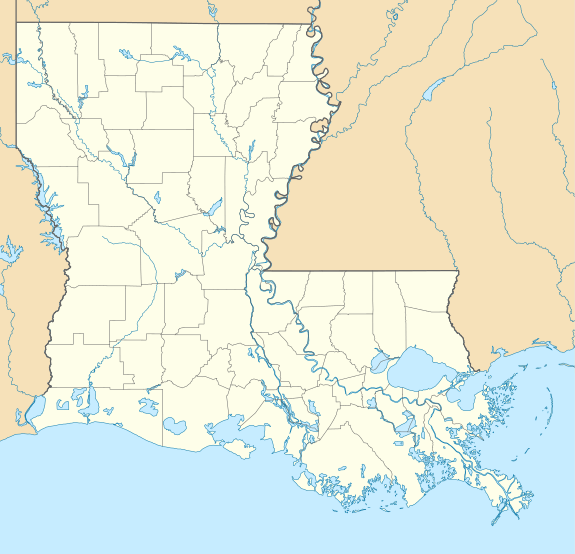Palo Alto Plantation (Donaldsonville, Louisiana)
Palo Alto Plantation is an historic mansion located at the corner of LA-1 and LA-944, along Bayou Lafourche in Donaldsonville in Ascension Parish, Louisiana. It was built in c.1847 and was added to the National Register of Historic Places on April 13, 1977.[1][2] The architecture is an Anglo-Creole type Louisiana plantation cottage decorated in Greek Revival style.[3]
Palo Alto Plantation | |
 | |
| Location | Northwest of the junction of Louisiana Highway 1 with Louisiana Highway 944 |
|---|---|
| Nearest city | Donaldsonville, Louisiana |
| Coordinates | 30°05′27″N 91°01′48″W |
| Area | 7 acres (2.8 ha) |
| Built | c. 1847 |
| Architectural style | Greek Revival, Carpenter Greek Revival |
| NRHP reference No. | 77000665[1] |
| Added to NRHP | April 13, 1977 |
History
The first recorded owners of the plantation were Pierre Oscar Ayraud and his wife, Rosalie Rodriguez, who acquired the house from succession of Rosalie's father, Mathias Rodriguez, in 1852. The house is thought to be designed by architect, James Dakin based on its style.[3][4]
This house was subject to multiple painting by French-born artist, Marie Adrien Persac (1823–1873).[4]
The plantation house is a 1 1⁄2-story building on brick piers with a twelve-foot-wide porch set under the roof line.[5][6] The window panes of the house are more than 170 years old and contain etchings with names and initials, and it is said to be how the family would check if their engagement diamond rings were real.[2] The doorknobs are lower than a modern home, because the average height of people was shorter.[2]
In 1860, the Lemann family purchased the home, and as of 2019 it is still owned by the family and used as a bed and breakfast and for events.[3][2]
References
- "National Register Information System". National Register of Historic Places. National Park Service. November 2, 2013.
- Williams, Matt (2019-08-16). "Opening its doors, Palo Alto Plantation ready to show off over 170 years of history". wafb.com. Retrieved 2020-03-20.
Peter is the latest Lemann to own the old place, which was built back in 1847 by Pierre Oscar Ayraud, a relative of his. It was purchased by the Lemann side of the family in 1867, and the family has owned it ever since.
- "HABS LA-1321 (sheet 1 of 10) - Palo Alto Plantation House, Donaldsonville, Ascension Parish, LA". Library of Congress, Washington, D.C. 20540 USA. 1933. Retrieved 2020-03-20.
- Editor-in-chief, Greg Fischer. "Palo Alto Plantation opens its doors". Donaldsonville Chief. Retrieved 2020-03-20.CS1 maint: extra text: authors list (link)
- Malone, Lee (2007). The Majesty of the River Road. Pelican Publishing Company. p. 70.
- Bernard, Peter and Arthur A. Lemann, Jr. (August 1976). "National Register of Historic Places Inventory/Nomination Form: Palo Alto Plantation". National Park Service. Retrieved March 19, 2018.CS1 maint: multiple names: authors list (link) With 38 photos and pictures.
See also
- National Register of Historic Places listings in Ascension Parish, Louisiana
- Palo Alto Plantation House architecture drawings (1933) at Library of Congress

